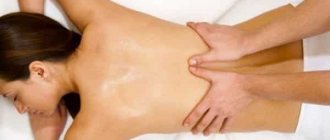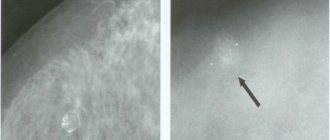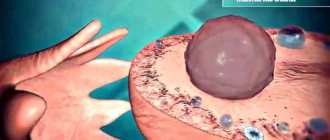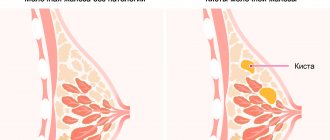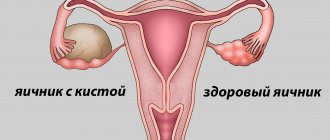Authors | Last updated: 2019
An ovarian cyst detected in a woman does not always require immediate treatment. Some neoplasms are prone to spontaneous regression, but they take time to resolve. A woman comes under the supervision of a gynecologist, and her lifestyle changes. The presence of pathology imposes certain restrictions, which the doctor should discuss during a face-to-face consultation.
What should you not do if you have an ovarian cyst? First of all, you should not self-medicate and uncontrollably take various medications and dietary supplements. Not all alternative medicines are applicable in the treatment of the disease. Physical activity, heat exposure, and some cosmetic procedures are not recommended. Living with an ovarian cyst means following all prescribed restrictions and carefully monitoring your condition. If you feel worse, you should consult a doctor as soon as possible.
Why do restrictions arise with ovarian cysts?
A cyst is a cavity filled with serous or hemorrhagic fluid. It grows from ovarian tissue and can reach a significant size - up to 10-15 cm or more. Some neoplasms are connected to the organ by a thin stalk, others are located on a broad base. Some cysts have a thick and durable capsule, while others are thin-walled. They all receive nutrition from the vessels supplying the ovary.
Main types of ovarian cysts.
Ovarian formation is always a potential source of danger for a woman. At any time, a simple cyst can become complicated. The following conditions may develop:
- Torsion of the cyst stalk. It occurs when the formation is connected to the ovary by a thin and long cord. Leads to organ necrosis and, in the long term, to peritonitis and sepsis;
- Rupture of the cyst capsule. Accompanied by hemorrhage into the ovary and pelvic cavity. Leads to disruption of internal organs and peritonitis.
The likelihood of complications depends on the type of cyst. It is known that follicular and luteal formations are more likely to twist, and endometriomas are more likely to rupture. Complications occur predominantly on the right side. The tumor of the left ovary is fixed by the intestine and is less likely to undergo torsion or displacement.
The size of the tumor also affects the incidence of complications. The larger the lesion, the higher the likelihood of capsule rupture. As education increases, the risk of compression of the pelvic organs also increases.
Factors contributing to the development of complications:
- Intimacy (violent sexual intercourse);
- Sports activities, including those involving stress on the abdominal and pelvic muscles;
- Jumping, sharp turns, falling;
- Lifting weights;
- Thermal procedures;
- Pregnancy.
Let us consider in more detail what contraindications exist for ovarian pathology and what are the associated restrictions.
If you have an ovarian cyst, you should refrain from excessive physical activity and heavy lifting, so as not to provoke the development of complications.
Physical activity and sports
In the presence of ovarian formations it is not recommended:
- Work out in the gym with weight lifting;
- Perform exercises on the abdominal muscles;
- Practice intimate gymnastics;
- Do yoga asanas that involve stress on the abdominal and pelvic muscles;
- Twist the hula hoop, especially with weights;
- Run faster;
- Ride a bike;
- Perform abdominal vacuum and other similar procedures.
Exercises and stress on the abdominal muscles are contraindicated for cystic formations in the ovaries.
Thermal treatments
For ovarian cysts it is not recommended:
- Visit the Finnish sauna, Russian bath, hammam, etc.;
- Sunbathe on the beach during peak solar activity;
- Visit the solarium;
- Take a hot bath or shower (more than 37 degrees);
- Steam your feet, take hot foot baths;
- Place mustard plasters on your calves;
- Do thermal wraps on the abdomen and lower back.
Neoplasms of any origin cannot be heated. As body temperature rises, blood flow increases, including in the pelvic organs. Activation of blood flow improves the nutrition of the cyst and provokes its growth. As the size of the lesion increases, the likelihood of developing dangerous complications increases.
Thermal procedures on the lower abdomen with an ovarian cyst are strictly contraindicated.
It is important to know
Thermal procedures are strictly prohibited during cyst suppuration and when a malignant tumor is suspected.
Ovarian pathology is not a reason to refuse to visit the beach and go to the sea. You just need to take precautions. It is not recommended to sunbathe between 11 a.m. and 3 p.m.—at this time the sun is most active. It is important to avoid overheating, spend more time in the shade and in air-conditioned rooms, and wear comfortable clothes that suit the season. You can swim in the pool without restrictions.
Can a breast cyst resolve on its own?
There is an opinion that cysts in the mammary glands resolve on their own, and no treatment is required.
In fact, such cases have happened, but they are isolated. Taking such a risk is very dangerous. Even the smallest cyst can grow. Treatment of a small cyst is carried out conservatively.
If the cyst has reached a size of up to one and a half centimeters, then the doctor prescribes a puncture to collect the contents.
Air or ozone is introduced into the empty cavity. Such a cyst needs to smooth out the walls, and treatment with traditional methods in this case is prohibited. The doctor monitors the dynamics of the cyst, and only after that prescribes the necessary treatment.
Massage
Any mechanical impact on the cyst projection area can lead to the development of complications:
- Displacement of the ovarian tumor and disruption of the pelvic organs;
- Damage to the capsule, its rupture and hemorrhage;
- Torsion of the pedicle of the formation, leading to ovarian necrosis;
- Increased blood flow in the pelvic cavity, which leads to the growth of the lesion.
Performing a massage for an ovarian cyst requires the exclusion of certain areas and methods of the procedure.
For ovarian cysts it is not recommended:
- Impact the lumbar and pelvic region, lower abdomen and back;
- Perform gynecological massage;
- Practice anti-cellulite massage.
Massaging other areas, including the head, neck, and limbs, is permitted and does not pose a danger to the woman.
Drug treatment
For a resolving effect on the cyst, Longidaza and Karipain are used. They allow you to eliminate adhesions of the meninges.
When an infectious or autoimmune process occurs, you must first find all these inflammatory foci in the body and eliminate them. To correctly select anti-infective treatment, as well as the use of immunomodulators, it is necessary to conduct blood tests to determine the type of infection, as well as immune status.
If a brain cyst provokes circulatory problems, then the concentration of cholesterol in the blood will also need to be reduced. In addition, it is necessary to restore blood pressure. The course of treatment will consist of using several types of drugs together, such as Nootropics and Antioxidants.
Cosmetology procedures
Important aspects:
- For benign ovarian tumors, mechanical and laser hair removal are permitted. Photoepilation is carried out with caution. Exposure to heat can negatively affect the course of the disease and increase symptoms. If possible, you should refrain from photoepilation until the cyst is removed;
- In case of pathology of the appendages, it is not recommended to carry out any thermal procedures on the lower abdomen, back, or perineum;
- Manipulations involving effects on the abdominal and lower back muscles are not permitted.
Before carrying out any procedure, it is important to clarify exactly how it affects the condition of the pelvic organs. If there is a risk of increased blood flow in the ovaries or mechanical displacement of the organ, you should refrain from manipulation.
Possible side effects from cosmetic procedures should be discussed in advance.
Treatment with folk remedies
When the brain cyst does not increase in size and does not manifest itself in any way, then surgery is not required, nor is serious drug treatment. You can use folk remedies. This therapy is based on the use of different types of decoctions and infusions at home.
For cooking you should use the following recipes:
- Take 1 tbsp. l. yeast, which needs to be stirred in 3 liters of warm water, and then add 40 g of elecampane. Leave the mixture for several days in a dark place to allow it to mature. You need to use this product 4 times a day, half a glass, for 3 weeks;
- You need to squeeze the juice out of fresh burdocks. 15 g of it should be consumed in the morning and also in the evening before bed. The course of admission is several months;
- You can also use an oil solution of hemlock, which will need to be instilled into the nose. To make it, you need to mix 50g of seeds with 0.5 liters of olive oil and leave to infuse for 21 days. After this, the mixture must be strained and 2 drops of this product must be instilled into the nose 3 times every day.
Intimacy
There is no categorical ban on sexual activity with an ovarian cyst. It is only recommended to be careful and listen to your feelings. According to reviews, many women note the appearance of nagging pain in the lower abdomen during sex. During sexual intercourse, the formation is slightly displaced, which leads to tension in the ligaments and the appearance of some discomfort. If the pain intensifies, you should refrain from intimacy.
It is recommended to completely abstain from sexual activity for large tumors (10 cm or more). Typically, such cysts are treated promptly, and surgery is not delayed for long. 3-4 weeks after the operation you can have sex without any special restrictions.
If you experience pain or discomfort during intimacy, you should consult a gynecologist.
Nutrition and diets
If you have benign ovarian tumors, you can eat almost anything. There are no special prohibitions, since it is not known for certain whether nutrition affects the growth of the cyst. It has been suggested that consuming large amounts of fatty, fried and spicy foods increases the production of estrogen and the progression of the disease. For this reason, it is also recommended to avoid store-bought sweets, baked goods, fast food and processed foods.
Important aspects:
- Nutrition for ovarian cysts should be balanced in proteins, fats and carbohydrates. It is important to keep the body in good shape so that it can cope with the load;
- In the autumn-winter period, it is recommended to take additional vitamins. You can choose balanced multivitamin complexes. Women planning a pregnancy after getting rid of a cyst should start taking folic acid at a dosage of 400 mcg 3 months before conceiving a child;
- Strict diets for the purpose of body shaping are not recommended. You can and should monitor your weight, but weight loss should be gradual. Sudden weight loss threatens hormonal imbalance and progression of the disease.
A diet for ovarian cysts should be aimed at generally strengthening the body and reducing the consumption of foods that promote the production of estrogen.
It is important to know
If you have an ovarian cyst, the diet should be agreed with a specialist.
Prognosis and methods of prevention
It is known that these tumors can degenerate into cancer. The risk of this is low. If a frozen cyst of the intermediate velum is detected and there are no symptoms, then the prognosis is more favorable. A timely operation allows for complete restoration of brain function. The prognosis is relatively favorable. If a brain cyst is not treated, the consequences can be very serious, including the development of a stroke. Untimely therapy can cause the formation of adhesions. In this case, even after surgery, epileptic seizures are possible. Simple anticonvulsants do not help such people. Once a brain cyst is detected, treatment is effective in most cases. To reduce the risk of developing the disease you need to:
- prevent and promptly treat infectious pathology; exclude injuries;
- observe safety precautions;
- give up extreme sports;
- lead a healthy lifestyle.
In order to prevent the formation of echinococcal neoplasms, you need to thoroughly wash vegetables, berries, fruits and herbs, boil water before consumption, and conduct an examination of meat. Thus, cystic cavities are a dangerous pathology. Conservative therapy is not effective for it.
Drinking alcohol and smoking
There are two reasons to stop drinking alcohol if you have an ovarian cyst:
- Drinking alcoholic beverages dilates blood vessels, increases blood supply, including to the pelvic organs, and can promote the growth of tumors;
- In the treatment of ovarian cysts, hormonal drugs and other medications are often used. Many of them are poorly compatible with alcohol. You should not increase the load on the liver and drink even low-alcohol drinks (including beer).
Cavity formation in the brain
Cysts in the brain are benign neoplasms, which are a bubble with liquid contents inside. Young children and adults face a similar problem. Not everyone knows what a cyst is. This formation can be localized in any part of the brain. Large cavities in the frontal lobe often cause secondary (symptomatic) arterial hypertension.
They are localized both in the left hemisphere and in the right. The clinical picture of the disease largely depends on this. Congenital cysts most often appear between the ages of 30 and 50 years. The growth of these tumors can be fast or slow. In the latter case, wait-and-see tactics are often used. Cysts in the brain can be arachnoid (located in the area of the arachnoid membrane) and intracerebral. Depending on the location, the following types of neoplasms are distinguished:
- pineal gland;
- dermoid;
- choroid plexus;
- colloidal.
A temporal lobe cyst is often found. There is a classification according to the etiological factor. There are parasitic (echinococcal), post-stroke, infectious and traumatic cavity formations in adults and children.
Contraception and pregnancy planning
Against the background of an ovarian cyst, you can:
- Take birth control pills - combined contraceptives and mini-pills;
- Insert the vaginal ring;
- Place an intrauterine hormonal device;
- Use barrier methods of contraception: condoms and spermicides.
When choosing a contraceptive against the background of an ovarian cyst, you should consult a gynecologist, since many contraceptives affect the formation.
In most cases, planning a pregnancy is recommended after getting rid of an ovarian cyst. Many hormonal contraceptives, including COCs, the NuvaRing ring and the Mirena coil, have a beneficial effect on a woman’s reproductive function. They normalize the balance of hormones, restore the menstrual cycle and lead to regression of functional and endometrioid cysts. After stopping the contraceptive, the chances of conceiving a child increase.
It is important to know
Hormonal contraceptives do not affect the development of organic ovarian cysts (paraovarian, dermoid), but they cannot harm either. If the formation has reached a large size, you should consult a gynecologist. In some cases, the use of contraceptives will be preceded by surgery.
You can have children with an ovarian cyst, but the presence of pathology increases the risk of complications during pregnancy:
- Spontaneous miscarriage in the early stages;
- Placental insufficiency;
- Preeclampsia;
- Premature birth.
Ovarian cysts during pregnancy require special control and monitoring of the condition.
During pregnancy, the risk of torsion and rupture of the cyst increases, which may require urgent surgical intervention. For this reason, it is recommended to first remove the pathological focus and only then plan a pregnancy.
On a note
Follicular and endometrioid cysts can cause infertility. Pregnancy can occur after removal of the lesion.
Breast massage technique for pathology
Performing a massage requires certain skills and knowledge of how to do it correctly so as not to cause harm.
Breast massage for mastopathy should be carried out as follows:
- The initial stage is gentle massaging of the nipples and their areolas.
- Apply light pressure to the entire circumference of the chest. All movements are performed using two fingers.
- When performing manipulations, special attention should be paid to the condition of the skin. If there is no redness, then the procedure is carried out further.
- Pressure on the chest should be smooth and soft, unlike palpation.
- The total duration does not exceed 10 minutes.
You can massage using gels and tonics that cleanse and moisturize the skin, which have a calming effect.
You should not take creams with high fat content or use jars for massage. Oils that do not contain alcohol or its components are suitable. This component not only dries the skin, but also promotes tissue heating, which, in turn, affects the accelerated growth of pathological cells.
Medical manipulations and therapeutic procedures
If we analyze the most frequently asked questions from patients, we can answer this:
- In case of ovarian pathology, it is possible and necessary to do endoscopic examinations of the digestive tract - irrigoscopy, colonoscopy, fibrogastroduodenoscopy. The formation of appendages can be a metastasis from the abdominal organs, and this can only be determined after a thorough diagnosis. The risk increases after age 40;
- An ovarian cyst is not a contraindication to cauterization of cervical erosion or removal of cervical polyps;
- For ovarian formations, hysteroscopy with diagnostic curettage of the endometrium is performed. This analysis allows you to assess the condition of the uterus and identify concomitant pathologies;
- Physiotherapy is used to accelerate the regression of functional ovarian cysts, as well as after surgery. Electrophoresis with enzyme preparations and vitamins, magnetic therapy, and ultrasound are used. Thermal warming manipulations and darsonval are not recommended. Water procedures are carried out with caution, including radon and mineral baths and ozone therapy.
Any examinations and treatment procedures must be agreed upon with a gynecologist.
When planning any medical procedures, you should definitely discuss with your doctor the possibility of carrying them out if you have an existing ovarian pathology.
On a note
For ovarian cysts, alternative medicine methods are not recommended: acupuncture and hirudotherapy. These procedures increase blood flow in the pelvic organs and can provoke the growth of the lesion.
Patient examination plan
The attending physician (neurologist) should help the patient get rid of the symptoms. If left untreated, a cyst, like a benign tumor, can develop into cancer. This happens very rarely. A brain cyst needs to be treated after a comprehensive examination. Initially, the patient is examined and interviewed. The following studies are being carried out:
- computed tomography or magnetic resonance imaging;
- electroencephalography;
- puncture;
- cerebrospinal fluid examination;
- ophthalmoscopy;
- biomicroscopy;
- audiometry;
- measurement of intracranial pressure;
- perimetry;
- general clinical tests;
- angiography;
- biochemical blood test;
- coagulogram.
If symptoms of a brain cyst appear after a stroke, then blood flow must be assessed. For this purpose, Doppler ultrasound and tomography are performed. Neurosonography allows identifying cystic cavities and tumors in young children. Differential diagnosis is carried out with hematoma and abscess.
It is imperative to exclude a malignant tumor. Before treating a cyst, it is necessary to conduct a parasitological study. This allows us to exclude echinococcosis, paragonimiasis and taeniasis. It is easiest to identify a tumor on the brain. It is localized on the surface. The situation is more difficult if there is an intracerebral cyst. To make a diagnosis, a neurological examination is required. The doctor determines reflexes, range of motion, eye reaction and sensitivity.
Taking medications
For ovarian cysts, medications that have a beneficial effect on hormonal levels and promote regression of the lesion are recommended for use:
- Combined oral contraceptives with strong gestagens (Regulon, Marvelon, Zhanin, Novinet, Lindinet, Yarina, Jess, Klaira, etc.);
- Progestin agents (Duphaston, Utrozhestan, Visanne, Norkolut, etc.);
- Gonadotropin-releasing hormone agonists (Lukrin, Buserelin, etc.).
The choice of COC should be strictly individual, taking into account all the features of the neoplasm.
As an auxiliary measure, the following are prescribed:
- Anti-inflammatory and painkillers;
- Antibiotics and antifungal drugs;
- Probiotics to restore the microbial flora of the vagina and intestines;
- Vitamins and dietary supplements;
- Immunity stimulants;
- General tonic and strengthening drugs (Befungin, Cyclim, Klimadinon) of plant origin. Prescribed with caution and under control of tumor growth.
It is not recommended to take medications that lead to an increase in the level of estradiol in the blood. This hormone promotes cyst growth and disease progression.
Homeopathic medicines (Ovariamin, etc.) for pathology of the appendages are prescribed only as a symptomatic remedy. The effectiveness of homeopathy has not been proven.
It is important to know
Self-medication is unacceptable. Any medications can be taken only as prescribed by a doctor. Uncontrolled use of medications risks deterioration of the general condition, development of side effects and progression of the disease.
Life without restrictions: what happens if you ignore your doctor’s recommendations?
Active physical activity, thermal procedures, irrational use of medications - all this can lead to an increase in education and the development of complications. The following symptoms indicate torsion or rupture of the cyst capsule:
- Sharp pain in the lower abdomen - left or right;
- Nausea, possible vomiting;
- Retention of stool, gas, urination;
- Abdominal muscle tension;
- Paleness of the skin;
- Reduced blood pressure;
- Bloody vaginal discharge.
If such symptoms occur, you need to provide the woman with complete rest, put ice on the lower abdomen and call an ambulance. Once the diagnosis is confirmed, surgical treatment is indicated.
